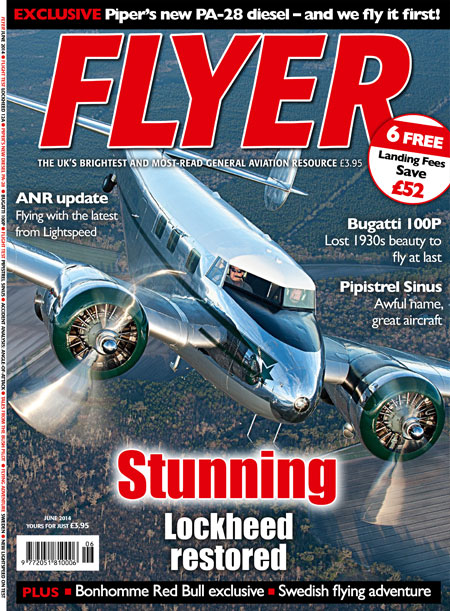The Lockheed 12 was officially known as the Electra Junior, but could have been called the "Lear Jet" of the 1930's. At that time, the US was in desperate need of "feeder airline" that could serve in the role of what is known today as commuter vehicles. To help fill that need, the US Bureau of Air Commerce sponsored a competition. Following their success with the legendary Electra, Lockheed decided to design a scaled down version of the plane to enter in the competition. In June of 1936, Lockheed won by default, being the only manufacturer to have its prototype completed on time.
The Model 12 was originally designed to carry 6 passengers and a crew of 2 and featured an onboard lavatory. It was very similar to the larger Electra in many ways, including an all metal structure. Having the same engines as the larger plane, it had greater performance and a top speed of 225 MPH. Though it did see limited use as an airliner, it proved more popular as a transport for executives and government officials. The Electra Junior offered a more luxurious and spacious cabin than any other plane that catered to the needs of the traveling VIP.
Primarily due to WWII, production of the Model 12 ceased in 1941, with a total of only 130 planes produced. Lockheed deemed it more critical to produce the larger aircraft that could better serve the war effort, leaving the production of corporate aircraft to Beechcraft (some say the similarities of D-18 Twin Beach to the model 12 is no coincidence). During WWII, many civilian Lockheed 12's, including this one, were requisitioned by the U.S. Military. The planes served in the US Army Air Force as the C-40 and flew for the US Navy as the JO-1.
In the months leading up to WWII, some Model 12s were even modified to serve as spy planes. Flying undercover as British Airlines, they overflew German and Italian military installations, mapping and secretly taking aerial photographs.
The Lockheed s/n 1250, built in 1938, is one of only 8 worldwide, still flying today. It represents the beauty and romance of corporate air travel which reached a high point in the Deco Era. The aircraft was meticulously restored in the livery in which it began its flying career - as the corporate aircraft for the Phillips 66 Corporation.
In 1935 Lockheed saw a need for a private twin-engine executive airplane as well as a small, fast "feeder" airliner. The Lockheed Model 10 Electra (of Amelia Earhart fame) was scaled down to create the Model 12 Electra, Jr. As a 6 passenger, all metal, retractable gear, FAST (200+MPH), transport, She went into production in 1936. About 135 examples were produced from 1936 til 1942. 30 were Army Air Corps UC-40s.
This Electra, Jr. was purchased by Phillips Petroleum in 1939. She was "Drafted" into the Army as a UC-40 D (42-66386) until 1945 when She was returned to Phillips Petroleum. In the 1950s She had several owners and Her NC 18970 registration was changed to N99K. In 1986, Kent and Sandy Blankenberg of California acquired Her and flew to many air show venues.
In October of 2009, She was acquired by David Marco. After two years of non-use, She was given a "Ferry Permit" and flown to Chino, Ca. for a twenty month re-license. Interior removed and reworked. All materials included "Burn Certs." Cabinetry was refinished, seat mountings replaced with new fastenings. Floor boards all replaced with new. All instruments overhauled and re marked with extra effort to keep the panel in 1930s style. All electrical wiring, switches,fuses,circuit breakers and electrical components replaced with new. Old radios,antennas, mountings,and hardware removed (over 120 pounds).Garmin radios installed by FAA form 337. Cabin entry door rebuilt, heat treated and reinstalled (FAA form 337). Landing gear system removed, stripped, NDTed, painted and reinstalled. Air Wheel brakes, wheels, tires , master cylinders , lines and seals replaced. Wheel fenders made new. Fuel tanks removed, inspected, pressure tested and reinstalled. All fuel,oil and hydraulic lines replaced with new. Fuel valves, pumps, motors, and primer components overhauled. Cowlings reworked, and painted to match the Phillips Petroleum scheme . The airframe paint was "touched up" to keep Her in the Phillips livery. Nose skins replaced as needed and dents removed when possible. Navigation lights replaced with Grimes 1930 era fixtures. Pratt and Whitney engines and propellers serviced and all hoses firewall forward replaced with new. Re weighed (6,722 lbs empty), NC 18097 registration number affixed. Airworthiness Certificate issued in April 2011. Test flown on April 27. After 15 hours of test flying in California, She was flown to Her new home in Jacksonville, Florida where She will continue to proudly show off Her "Art-Deco" lines and Her Lockheed Heritage.


